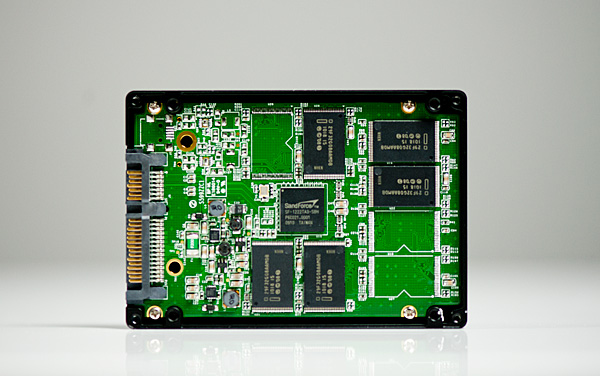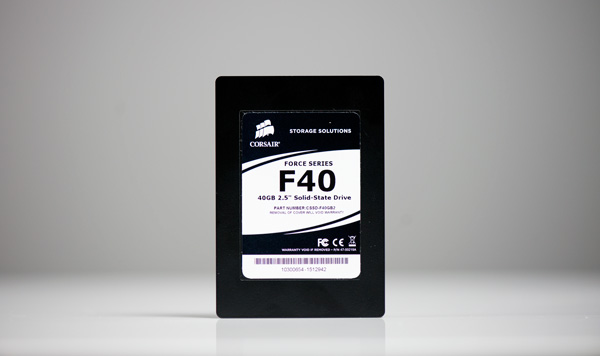Z68 SSD Caching with Corsair's F40 SandForce SSD
by Anand Lal Shimpi on May 13, 2011 3:06 AM ESTI have to admit that Intel's Z68 launch was somewhat anti-climactic for me. It was the chipset we all wanted when Sandy Bridge first arrived, but now four months after Sandy Bridge showed up there isn't all that much to be excited about - save for one feature of course: Smart Response Technology (aka SSD caching). The premise is borrowed from how SSDs are sometimes used in the enterprise space: put a small, fast SSD in front of a large array of storage and use it to cache both reads and writes. This is ultimately how the memory hierarchy works - hide the latency of larger, cheaper storage by caching frequently used data in much faster, but more expensive storage.
I believe there's a real future with SSD caching, however the technology needs to go mainstream. It needs to be available on all chipsets, something we won't see until next year with Ivy Bridge. Even then, there's another hurdle: the price of the SSD cache.
Alongsize Z68 Intel introduced the SSD 311, codename Larson Creek. The 20GB SSD uses 34nm SLC NAND, thus pricing the drive more like a 40GB MLC SSD at $110. Intel claims that by using SLC NAND it can deliver the write performance necessary to function as a good cache. Our benchmarks showed just that. The 20GB SSD 311 performed a lot like a 160GB Intel X25-M but with half of the NAND channels thanks to SLC NAND's faster write speed and some firmware tweaks. In fact, the only two complaints I had about the 311 were its limited capacity and price.
The capacity issue proved to be a problem as I found that after almost a dozen different application launches it wasn't too hard to evict useful data from the cache. The price is also a problem because for $100 more you can pick up a 120GB Vertex 2 and manage your data manually with much better performance overall.
Yesterday a friend pointed me at a now defunct deal at Newegg. For $85 Newegg would sell you a 40GB SF-1200 based Corsair Force SSD. That particular deal is done with and all that remains is the drive for $110, but it made me wonder - how well would a small SandForce drive do as an SSD cache? There's only one way to find out.

The Test
| CPU |
Intel Core i7 2600K running at 3.4GHz (Turbo & EIST Disabled) - for AT SB 2011, AS SSD & ATTO |
| Motherboard: |
Intel Z68 Motherboard |
| Chipset: |
Intel Z68 |
| Chipset Drivers: |
Intel 9.1.1.1015 + Intel RST 10.5 |
| Memory: | Qimonda DDR3-1333 4 x 1GB (7-7-7-20) |
| Video Card: | Intel HD Graphics 3000 |
| Video Drivers: | Intel GMA Driver for Windows 8.15.10.2372 |
| Desktop Resolution: | 1920 x 1200 |
| OS: | Windows 7 x64 |












81 Comments
View All Comments
hechacker1 - Friday, May 13, 2011 - link
Agreed. I wonder if anybody can hack the RST 10.5 driver to make it work on any intel chipset.I actually just modded my X58 bios to include the new Intel Raid option rom, version 10.5.0.744. Guess what? The Acceleration Options shows up in the raid bios.
Unfortunately, I don't have an SSD to see if it will work.
I also tried an even newer option rom, and that Acceleration Option is now grayed out...
Either way, this is just software it seems.
Anandtech, any idea if the z68 chipset has some hardware responsible for enabling cache?
mianmian - Friday, May 13, 2011 - link
The write frequency on the catching drive is much more frequent than a normal disk. MLC might not have enough endurance to survive long under this kind of load.Shadowmaster625 - Friday, May 13, 2011 - link
I would rather just manage two drives, and move whatever I'm not using over to the media drive. It's not that hard; it only takes a couple clicks to move a folder from drive C to drive E. And for people who are scared to death of performing such types of operations, I doubt they'd see a reason to justify an extra $100. They can just suffer with a single drive solution. At least until the SSD cache is reduced to no more than a $20-$40 premium. I still think an integrated flash controller and a SSD DIMM is the way to go, and intel is shooting themselves in the foot with this half*** solution. A 10 channel SSD controller built into the cpu would be so blazingly fast...qwertymac93 - Friday, May 13, 2011 - link
Hmm, price of 40gig Corsair force = $110Price of 60gig vertex 2 = $105
... Am i missing something here?
cactusdog - Friday, May 13, 2011 - link
The features of this platform sounded great on paper but in reality a bit of a letdown.For people with a SSD this caching thing is useless.
I'm guessing AMD/Nvidia's next gen cards will have a quicksinc like performance built into their gpus, making sandy bridge/Quicksinc not so attractive.
Sata 6GBs is nice but anyone can get that speed on older boards with a pci-e ssd or just RAIDing 2 SSDs.
The only really attractive thing is unlocked CPUs for a reasonable pric but. I'm gonna skip this platform........ by the end of the year this platform will look very average.
assafb - Friday, May 13, 2011 - link
1) A more useful configuration would have been the SandForce 40GB on Enhanced mode, but it has only been tested as maximized?2) A power user would use an SSD as the boot drive naturally, SSD caching alone would be inferior, of course, but that is not all that there is to it with SSD caching for the power user. This is the question - whether the 160GB mainstream SSD buyer that has a mainstream 2TB HD would be better off with a 160GB boot drive and no caching, or with 40GB partitioned out of his 160GB SSD to cache the HD and the remaining 120GB partition for the boot drive and critical apps. This question is relevant as for many users like myself, OS+apps+games exceed 160GB, and even the unaffordable 256GB+ SSDs, so some apps and games still have to get to the mechanical HD.
Anand Lal Shimpi - Friday, May 13, 2011 - link
1) Enhanced mode should perform similarly to maximized mode in read performance. Write performance should be lower, at least on the Hitachi drive.2) If you can fit your OS and apps on the 120GB partition, then the 120/40 setup is your best bet for tackling games in my opinion.
Take care,
Anand
assafb - Saturday, May 14, 2011 - link
Thanks!sparky0002 - Friday, May 13, 2011 - link
Go for broke. Build the quickest array you can behind a z68 chipset then throw a cache infront of it. It would suck if it ended up as the limit rather than as a booster. My guess is enhanced mode will perform better.but what I really want to know is... I've lived my life inside a 60gb partition for years. Games and the like are on another disk. so how would three SSD 311's in raid 0 V's a Revodrive go? No cache just a straight test of the SLC drives.
don_k - Saturday, May 14, 2011 - link
'so how would three SSD 311's in raid 0 V's a Revodrive go'Not even close. The first gen revodrive does 500MB/s read/writes. Second gen doubles those numbers. So three 311 would give you maybe ~300MB/s at a higher price than a first gen revodrive.